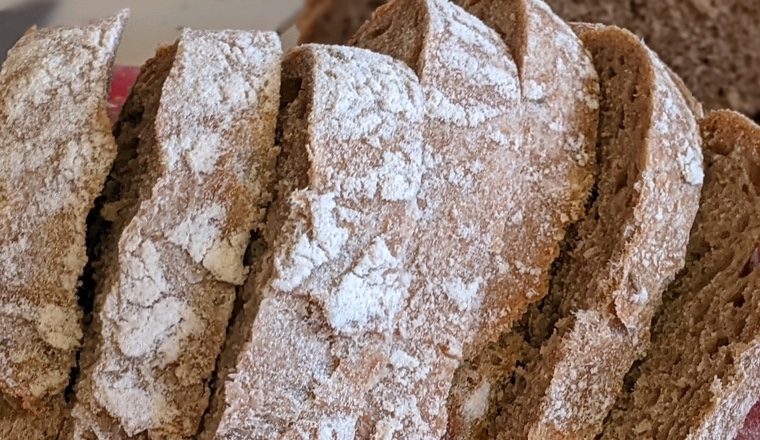
Phil’s Sour Sam Sourdough Bread (Early Bird Farm Variation)
Making a good sourdough bread is a craft, like making a good French baguette or croissant. A craft is defined as the ability to create a good product predictably and repeatedly. Achieving this with a complicated and lengthy process, like that of sourdough bread, is difficult and requires patience, determination and practice – lots of practice. When you can feel what is happening with your dough through your hands and can adjust to things outside your control, like weather, yeast, that damn oven and the variations in your flour, and consistently take beautiful loaves out of the oven, you will feel rare pride in your craftsmanship. Stick with it through the difficult early and middle loaves. It will be worth it.Good sourdough bread takes time, approximately 24 hours, to make and to enable your wild yeast (your starter) to break down the grain and to develop complex flavors, i.e., to do its thing. There are a series of steps that define the process around which I have organized the recipe below and the schedule which I use. That schedule allows me to get a good night’s sleep and to have a regular workday available sans involvement with the dough.Enjoy,Phil Turner
Equipment
- Dutch Ovens with flat top, e.g., Lodge L8DD3 Cast Iron Dutch Oven, 5 qt (flat top) or equivalent
- 2 quart acrylic containers with lids
- Round 10” bannetons
- Bench knife (steel)
- Bowl scrapper (plastic)
- Instant-read thermometer
- Wooden bowl with cover (wood bowls seem to work best because of their insulating qualities, but any large bowl will do. I use a large, 14”, wooden salad bowl)
- Stand mixer/hand mixer (if you make a lot of bread, a stand mixer is a godsend)
- Space in refrigerator (set to approximately 40 degrees) for two bannetons
- Scale (in grams)
- Large plastic bags for sealing the proofing containers (bannetons)
Ingredients
Part 1
- 50 grams starter
- 220 grams filtered water at 70+ degrees (room temperature)
- 125 grams Early Bird Farm All Purpose Flour
- 125 grams Early Bird Farm Espresso Hard Red Wheat Flour
Part 2
- 500 grams Early Bird Farm All Purpose Flour
- 300 grams Early Bird Farm Whole Wheat Flour
- 100 grams Early Bird Farm Rye Flour
- 675 grams water (75-85 degrees- cooler in summer/warmer in winter)
Part 3
- 1,575 grams autolyze
- 21 grams salt
- ¼ tsp instant yeast (winter)
- 250 grams levain
Instructions
Part 1: Feed the starter/create a levain for two loaves (7:30AM)
For this relatively small quantity of bread, two loaves, I feed the starter and make the levain (to be used later to make the dough) in the same container. The ingredient quantities below provide for 250 grams of levain and 50 grams for sustaining the starter with a bit extra.
- Place starter in clean container with cover.
- Add flours.
- Add water and mix thoroughly and cover.
- Let sit on counter for 8 to 10 hours.
- After removing the 250 grams of starter/levain for making your dough at around 6:00 pm (see step 3 below), cover and leave the remaining starter overnight for feeding in the morning.
- Return to step 1 (above) the next morning. You could also place 100 grams or so of starter in a container and keep in refrigerator for a few days to two weeks.
Part 2: Assemble the autolyze (5:00PM)
The purpose of this step is to begin to break down the grain (flour) for digestibility and flavor by wetting the flour before you start making your dough.
- Mix flours and water until flour is thoroughly wetted and let sit, covered, for 20 to 60 minutes.
Part 3: Make your dough (6:00PM)
- Add salt and levain to autolyze (and ¼ tsp yeast in Winter).
- Mix for 10 to 15 minutes in stand mixer (or with hand mixer).
- Transfer dough to a large wooden or ceramic bowl to begin “bulk rise.”
- Fold #1: After 20 to 30 minutes, uncover and grab a handful of dough, lift and stretch it. Do this 4 to 8 times, turning the bowl as you go, until dough feels elastic and strongly resists your pull. Re-cover dough.
- Fold #2: After another 20 to 30 minutes to let dough relax, fold per 4 above.
- Fold #3 (final folding step): After another 20 to 30 minutes fold per 4 above.
- Let rise additional time to approximately double in bulk (about 60 minutes in Winter)
Part 4: Shape dough (8-9:00PM depending on ambient temperature/time of year)
- Take dough out of bowl and place onto a floured surface and cut in half
- Shape each half into a tight hemisphere, pulling the seams together underneath with the little finger of each hand, creating tension throughout the surface skin.
- Place each loaf in a floured banneton.
- Enclose each banneton in a large plastic bag and secure (I use a clothes pin).
- Place in refrigerator for 8 to 10-hour overnight rise.
Step 5: Bake your bread (6AM)
- Place Dutch ovens in kitchen oven and heat to 475 degrees, ensuring Dutch ovens are fully to temperature, i.e., leave in oven 15 to 30 minutes past when oven reaches 475 degrees.
- Take bannetons quickly out of refrigerator and out of plastic bags and dust exposed tops of dough with flour.
- Remove Dutch ovens from oven and open.
- Tip dough rounds from the bannetons into the tops of the Dutch ovens (the shallow part).
- Quickly cover dough with the deep tops of the Dutch Ovens and place into oven. (note: this whole process from taking the dough out of the refrigerator, dusting them, placing them in the Dutch ovens and returning them to the oven should take well under a minute see principle # 3, below)
- Set timer for 25 minutes and reduce temperature to 450 degrees.
- At 25 minutes, remove lids, reset timer to 15 minutes and turn temperature to 460 degrees.
- After 15 minutes, remove bread from oven (internal temp of bread should be 203 to 207 degrees)
- Place bread on wire rack to set for 30 to 60 minutes before slicing.
- Admire the beauty of your loaves.
- Share and savor your bread.
Notes
Notes:
A. Higher temp in your kitchen means faster rising
B. An older/longer developing levain equals a more sour sourdough bread.
C. Wet dough will stick to hot iron – hence the dusting of the loaves mentioned above (Step 2)
* We are very lucky to have our own excellent miller in Western Nevada County, Drew Speroni at Early Bird Farm. Note: Early Bird Farm’s fresh milled flour needs to be stored cold, ideally in your freezer or refrigerator, to prevent it from becoming rancid in the Summer. Fresh flour retains the oils and nutrients which are removed during milling by large scale/industrial millers in order to increase shelf-life.
Sourdough principles:
1. Time equals flavor and digestibility, i.e., give your yeast a chance to do its work
2. Moisture equals crustiness (a higher hydration/wetter dough makes a crustier bread)
3. Temperature differential at baking drives “oven spring” (a cold dough in a hot baking vessel increases the size and improves the appearance of your loaf)
4. The sourdough bread process is sensitive to seasonal/temperature change, water temperature and even flour temperature, e.g., cooler temperatures in your kitchen require longer rise times. Warmer water speeds up rise times. (For example, bulk rise (encompassing the folding steps) in winter is 2 ½ to 3 hrs. vs 1 ½ to 2 hrs. in summer)
